Bodybuilding wisdom suggests that squats, leg presses, lunges, and leg extensions are the best way to build your quads. As such, most leg-building workouts are written around these tried-and-tested exercises.
But there are athletes out in the world who have amazingly well-developed legs who do relatively little strength training and don’t follow bodybuilding workouts.
Cyclists, speed skaters, and sprinters are three such examples.
And while it’s true that these athletes often include exercises like squats in their workouts, they’re a very small part of their training. Also, they tend not to do the moderate weight/medium rep style of training most commonly associated with building muscle size.
So, could it be that there are other reasons that these athletes have legs that make many bodybuilders jealous?
In this article, we explore how cycling can help you build bigger legs and provide you with a couple of workouts to try.
Level Up Your Fitness: Join our 💪 strong community in Fitness Volt Newsletter. Get daily inspiration, expert-backed workouts, nutrition tips, the latest in strength sports, and the support you need to reach your goals. Subscribe for free!
Muscle Hypertrophy 101
To understand how cycling can help you build bigger muscles, you need to know a little about how muscles grow, which is a process called hypertrophy.
The mechanisms and triggers for increasing muscle size are well known. To build muscle, you need (1):
Overload – this means exposing your muscles to more work than they are used to. There are a few ways to do this, including increasing your training weights week by week or doing more reps. This causes…
Microtrauma – intense training causes microscopic structural damage to your muscles. Your body responds by repairing the damage and laying down additional muscle tissue. This is a sort-of self-defense mechanism designed to protect your body from subsequent workouts.
Metabolic stress – intense bodybuilding training reduces blood flow into your working muscles. This is called hypoxia, meaning low oxygen. Hypoxia triggers a buildup of metabolic products, which are a stimulus for muscle growth. Substances produced due to hypoxia include lactic acid, growth hormone, IGF-1, and myostatin.
All this metabolic stress is typically accompanied by a pump which, as all bodybuilders know, is another trigger for muscle growth.
Read more about why getting a pump can help you build muscle here.
Lower body exercises like squats, leg extensions, and leg presses all produce these effects. When you do a set of, for example, moderately hack squats, and take that set to failure, you’ll experience overload, microtrauma, and metabolic stress. As a result, your legs should grow.
But, there is more than one way to create these effects, which is why cyclists and skaters often have big quads. Their chosen sports affect their muscles in much the same way as a bodybuilding workout. That’s why they have massive legs without significant amounts of strength training.
How Cycling Builds Bigger Muscles
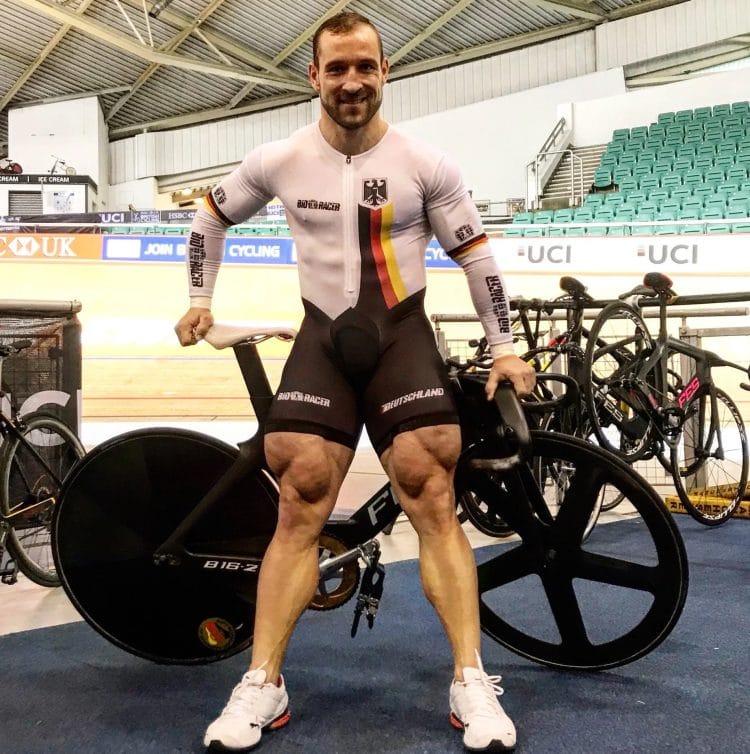
Cycling is mainly thought of as an aerobic activity. Aerobic means with oxygen. Low-intensity, long-duration cycling does not usually produce significant increases in muscle mass, which is why long-distance cyclists tend not to have massively-developed thighs.
That’s because endurance cycling mainly targets the slow-twitch type 1 muscle fibers. Red in color, these fibers are made for low-intensity, long-duration activities. They’re relatively slender, don’t have much growth potential, but are very resistant to fatigue.
However, cycling can be an anaerobic activity, too. Anaerobic means without oxygen. Track cyclists, who are the guys with massive thighs, compete over much shorter distances and pedal much harder and faster than road cyclists.
Track cycling involves greater recruitment of type 2b fast-twitch muscle fibers. 2b fibers are white, have a poor blood supply, and fatigue quickly. They also have far greater growth potential and are made for short but intense activities.
Cycling hard and fast will overload your muscles, cause microtrauma, and reduce blood flow, which are the conditions needed to trigger hypertrophy.
And that’s why some cyclists have bigger quads than you – their bike workouts are bodybuilding in disguise!
Why Use a Bike to Build Bigger Quads?
If traditional bodybuilding methods work, why would you even want to try and build your quads with a bike instead of a barbell?
Well, there are a few reasons why…
- Less knee stress – cycling is a joint-friendly activity. Even if you pedal against heavy resistance, you’ll probably find that cycling is easier on your knees than squats, leg extensions, and leg presses. So, if squats, leg presses, etc., hurt your knees, using an exercise bike could be a good alternative.
- No back stress – most leg exercises involve some, if not a lot, of back strain. Squats are highly compressive, and even leg presses put a lot of pressure on your lower back. There is no such back stress on an exercise bike, which means cycling is the ideal workout for anyone with lower back issues.
- More frequent workouts are possible – because cycling is easier on your joints and spine than squats, you’ll probably be able to do it more often. So, while most people can’t squat 3-4 times a week, you should be able to use an exercise bike several times a week, leading to faster increases in muscle size.
- Variety – as potent as free-weight, bodyweight, and resistance machine training are, you can have too much of a good thing. Do even the best exercises and workouts for long enough, and they’ll gradually become less effective. Using an exercise bike to train your legs means you have another workout tool to call on.
- Cardio by default – while you might be cycling for bigger quads, it’s impossible to avoid using your heart, lungs, and circulatory system, too. Better cardiovascular fitness is inextricably linked to better cardiovascular health, so it’s nice to know that your hypertrophy workout is also good for your general wellbeing and could help ward off illness and disease.
Tip: Choosing the appropriate bike size is crucial to prevent injuries or back pain. Follow this detailed guide and utilize the bike size chart to determine the perfect fit for you. Don’t forget to adjust the seat and handlebar height to ensure a comfortable ride. Before buying, take a test ride to confirm the suitability of the bike.
How to Build Bigger Quads with An Exercise Bike
Before we get into the nitty-gritty of building bigger quads through cycling, it’s important to stress that you don’t have to give up squats, leg presses, leg extensions, etc. Rather, using a bike to build your legs gives you an additional tool for your workout toolbox.
So, if you love squats (yes, I’m talking about you, Tom Platz!), then keep doing them. But, if you are struggling to build your quads or just want to try an alternative training method, then hitting the exercise bike instead of the weights could help.
Level Up Your Fitness: Join our 💪 strong community in Fitness Volt Newsletter. Get daily inspiration, expert-backed workouts, nutrition tips, the latest in strength sports, and the support you need to reach your goals. Subscribe for free!
With that out the way, here are some guidelines for building muscle with an exercise bike:
1. Lower the seat
When cycling for cardio, you want the seat relatively high so that your knees are almost straight at the bottom of each pedal stroke. This optimizes leg power and helps stop your quads from tiring too soon.
But, if you want to build bigger quads through cycling, you need to lower the seat to increase the range of motion at your knees and prevent your knees from straightening. This will increase hypoxia, starving your muscles of oxygen.
Lowering the seat on your bike will be like doing partial reps for your quads or wearing blood flow restriction bands.
2. Turn up the resistance
While hypoxia is an important factor for muscle growth, so too is overload. So, to build bigger quads, you need to challenge them with plenty of resistance.
Your body can’t differentiate between weights on a bar and working hard to push pedals around. It just knows work and tension. Providing you dial up the resistance, your cycling workout will overload your quads and increase muscle size.
3. Short sets
You can train hard, or you can train long, but you can’t train hard AND long. If you want to build muscle through cycling, you must adopt a bodybuilder’s mentality to cycling and do short sprints rather than longer, easier rides.
So, instead of pedaling for 20-30 minutes at a time, you’ll need to do short sets of 20-40 seconds or so. This will replicate the demands of strength training.
4. Do the “hover”
In bike-speak, hovering involves pedaling with your butt a couple of inches above the seat. While you don’t need to ride like this all the time, a few sets of hover sprints will leave your thighs pumped and burning. You’ll need to recruit your quads even more to support your body weight.
However, don’t be tempted to stand all the way up, as that will allow blood to flow more easily into your muscles, reducing hypoxia and negating some of the benefits of your workout.
5. If possible, use a fan-bike
While you can use any kind of bike to build your quads, fan-bikes (e.g., the Assault Bike) are arguably the best choice. That’s because the harder you pedal, the more resistance you’ll encounter. There are no settings to adjust – just pump your legs as hard as you can.
Using a fan-bike means you can push your quads to their limit, and, as you start to tire and slow down, the resistance will decrease to match your efforts. Think of using a fan-bike like drop sets for your legs.
However, most fan-bikes also have an arm action. Needless to say, you should NOT use your arms to take work away from your legs, as that would make your quad-building workouts less effective. Instead, sit up tall and keep your arms out of the way to ensure your legs are doing 100% of the work.
Exercise Bike Workouts for Bigger Quads
While you could just hop on an exercise and start pedaling, you’ll get better results if you follow a more prescriptive program. Here are three quad-building exercise bike workouts that will also burn calories and fat and improve your anaerobic fitness and endurance.
1. Pedal pyramid
This 12-minute workout starts easy and then gets harder every minute. It’s just like an ascending/descending strength training pyramid workout…
- 1-minute warm-up
- 5 seconds sprint/55 seconds easy pedaling
- 10 seconds sprint/50 seconds easy pedaling
- 15 seconds sprint/45 seconds easy pedaling
- 20 seconds sprint/40 seconds easy pedaling
- 25 seconds sprint/35 seconds easy pedaling
- 30 seconds sprint/30 seconds easy pedaling
- 25 seconds sprint/35 seconds easy pedaling
- 20 seconds sprint/40 seconds easy pedaling
- 15 seconds sprint/45 seconds easy pedaling
- 10 seconds sprint/50 seconds easy pedaling
- 5 seconds sprint/55 seconds easy pedaling
2. 20/70 intervals
In terms of work versus rest, 20/70 intervals closely mimic the demands of a typical bodybuilding workout. 20 seconds isn’t long, so make sure you work as hard as you can for each and every interval.
For this workout, simply sprint for 20 seconds and then pedal slowly for 70 seconds to recover. Repeat for 6-10 sets. Include hovers if you really want to thrash your quads.
3. Reverse Tabatas
Tabatas traditionally involve eight sets of 20-seconds of work alternated with 10-second recoveries. While this is a very taxing workout, the cardiovascular demands are so great that you won’t be able to pedal with maximum power for the entire workout.
Reverse Tabatas involve eight sets of 10-seconds work and 20-seconds of rest, which is much better for overloading your quads. This is still a challenging workout, but it’s over and done in four minutes.
Bigger Quads with Exercise Bike – Wrapping Up
While it may be sacrilegious to say it, you don’t have to squat to build bigger thighs. There is no denying the transformational power of squats. Still, there are other exercises and training methods that are just as effective.
That doesn’t mean you need to stop doing squats, but if you struggle to do them properly or simply don’t enjoy them, it’s worth exploring some different options.
Track cyclists are renowned for their well-developed legs, and at least some of that size is a result of riding a bike. From an analytical point of view, it’s clear that the demands of sprint cycling closely mirror those of bodybuilding, so this is not really much of a surprise.
So, if you want to build bigger quads but the traditional approach isn’t doing it for you, mount up and use an exercise bike instead. It could be the key to building the quads of your dreams!
References:
1– PubMed: The Mechanisms of Muscle Hypertrophy and Their Application to Resistance Training https://pubmed.ncbi.nlm.nih.gov/20847704/

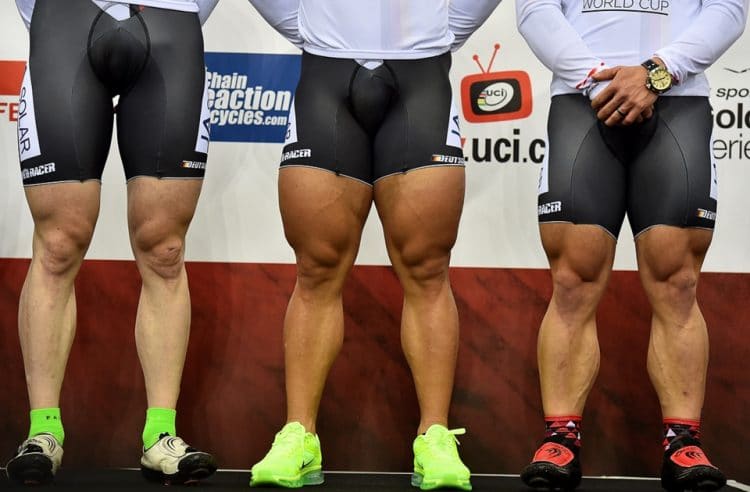
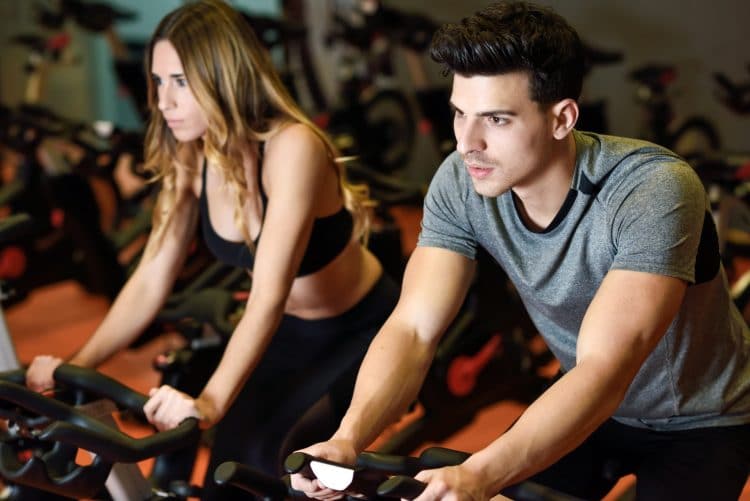
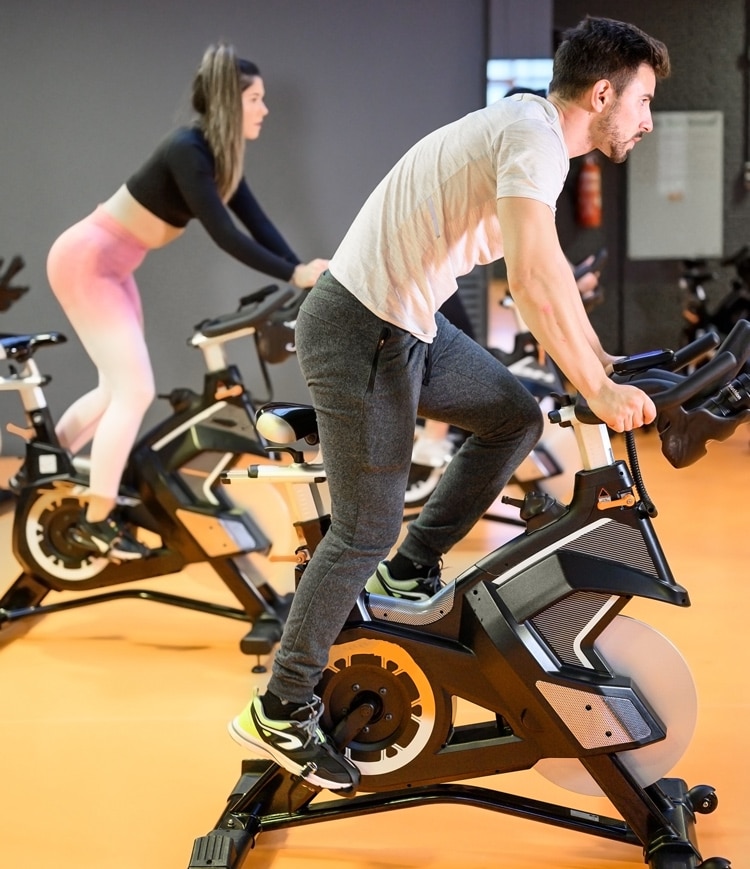
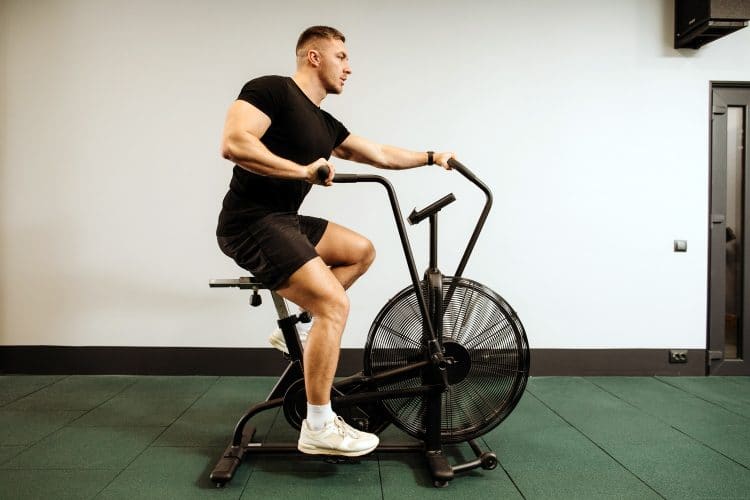






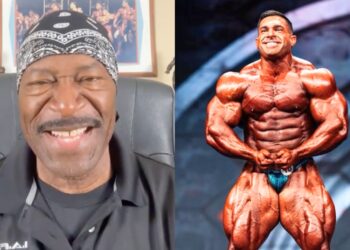

I am always surprised that I never hear anyone ask if maybe these Olympic or any high level athletes made it to where they are at because they where genetically gifted with a physique that is conducive to their sport and maybe it’s not their sport that caused that physique. I would be willing to bet that an Olympic cyclist would have decent size quads with basic strength training or even just a normal lifestyle. I’m sure there are people who enjoy a sport like cycling and would love to be an Olympic sprinter, but don’t have the genetics to make it to the top no matter how hard they try. And we are just using Olympic cyclists for the sake of discussion, but this could be for many other sports. You could also ask if gymnastics turns these men into mini bodybuilders or are they just naturally jacked little dudes. I would be interested in your thoughts on that. Thanks.
Hi Josh and thanks for your comment.
You raise an interesting point – nature vs. nurture.
I think that genetics determine your ultimate level of development/success, but you can always train your body to adapt to a degree.
However to be “elite,” you need the ideal genetic make-up.
For example, I’ve been a skinny triathlete weighing just 155 pounds and 205-pound powerlifter, with my body changing significantly due to my training and diet. I could never be elite in either of these sports as my genetics are not ideal, but I still managed to achieve a reasonable level of success.
It’s often said that form follows function and your body adapts to according to the type of training you do. In exercise, this is called the principle of specificity. But, if you’ve got the perfect genes, your results will always be better than someone less genetically blessed.
Even performance enhancing drugs won’t negate poor genes. That’s why it takes more than an armful of PEDS to make a Mr. Olympia.
This is certainly an interesting topic, and one I’m sure warrants further investigation.
That said, and going back to the original article, I’ve experienced some great leg gains from cycling, so I still stand by the idea that you can increase muscle size with these workouts because, under the right conditions, riding a bike can provide the overload that the quads need to grow.